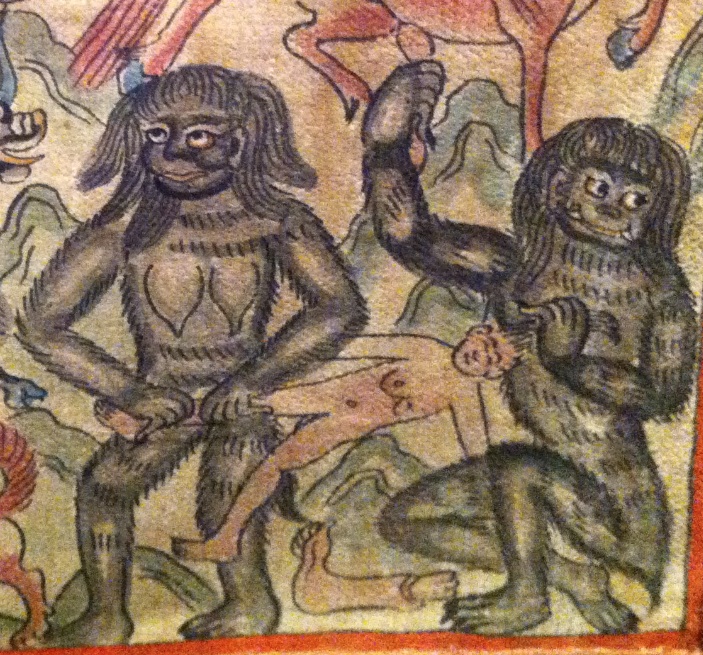Do Yetis Kill Humans?
Posted by: Loren Coleman on November 19th, 2012
During Assistant Director Jeff Meuse’s exhibiting of traveling displays from the International Cryptozoology Museum in New York City, he visited the Rubin Museum of Art. While there, he discovered intriguing imagery on a cloth painting.

Playing a “Where’s Waldo” game, Meuse and his assistant, the ICM’s coordinator of special events, searched the entire Himalayan art museum looking for signs of Yetis. Finally, he found one example.

The painting was dated to the 19th century from Mongolia.
The imagery is said to be “a depiction of the universe,” showing Mount Meru.
Mount Meru is a sacred mountain in Hindu, a giant location with several mystical, mythical, and heavenly aspects. A handful of western scholars have identified Mount Meru with the Pamirs, northeast of Kashmir, according to these sources.
In a corner of the Rubin’s Mount Meru painting is shown some Yetis.
Here’s what the panel about them says:

Did Yetis in the ancient past kill humans? The painters of this canvas apparently thought so.


About Loren Coleman
Loren Coleman is one of the world’s leading cryptozoologists, some say “the” leading living cryptozoologist. Certainly, he is acknowledged as the current living American researcher and writer who has most popularized cryptozoology in the late 20th and early 21st centuries.
Starting his fieldwork and investigations in 1960, after traveling and trekking extensively in pursuit of cryptozoological mysteries, Coleman began writing to share his experiences in 1969. An honorary member of Ivan T. Sanderson’s Society for the Investigation of the Unexplained in the 1970s, Coleman has been bestowed with similar honorary memberships of the North Idaho College Cryptozoology Club in 1983, and in subsequent years, that of the British Columbia Scientific Cryptozoology Club, CryptoSafari International, and other international organizations. He was also a Life Member and Benefactor of the International Society of Cryptozoology (now-defunct).
Loren Coleman’s daily blog, as a member of the Cryptomundo Team, served as an ongoing avenue of communication for the ever-growing body of cryptozoo news from 2005 through 2013. He returned as an infrequent contributor beginning Halloween week of 2015.
Coleman is the founder in 2003, and current director of the International Cryptozoology Museum in Portland, Maine.










One of the Yetis is a female. They’re also killing a female. Curious.
interesting…. problem is you’re talking about a “creature” that hasn’t been proven to exist.
wouldn’t it makes sense to prove it FIRST, before assuming these things?
makes no sense.
Does it depict a meh-teh, a dzu-teh or a “Yeti”? All stories of attacks and eating of humans are WAY beyond anecdotal. Kinda like the Big Bad Wolf stories, meant to scare kids into line. But first the creature must be defined, and the late Ivan Sanderson did a wonderful job of showing that several cryptid hominids had been sloppily lumped into one.
I personally haven’t seen one account of cryptids yetis eating humans that is one bit credible. Could it have happened? Yeah, maybe.
Since Yeti are endemic to areas with colder climes/ higher altitudes, it would make sense that they (like Polar bears) would be more carnivorous than their southern cousins (Bigfoot, Sasquatch, Skunk Ape, etc…) who would tend to be more omnivorous. During scarce times it’s possible an opportunistic Yeti might waylay some unwary traveler… but like Goodfoot says, they’re more likely used as the bogey man: apochryphal eaters of children who stay out too late and don’t mind their parents.
Interesting… they’re clearly pictured with tails. Any reports out there of Yeti having tails?
Ah, dconstrukt writes, “problem is you’re talking about a ‘creature’ that hasn’t been proven to exist.”
What “problem”? What do you think cryptozoology is about?
Why do you think shelves and shelves of books have been written about Yetis?
Cryptozoology discusses the appearance, behavior, lifestyles, habits, and more concerning animals as yet not verified. Again, with what do you think “cryptozoology” concerns itself?
Alamo: I seem to recall some accounts of MEH-TEHS having tails. They are more bestial in appearance and ways than the other cryptid hominids that are often lumped under the “Yeti” category. It’s a little complicated to go into here. If you haven’t read Ivan Sanderson’s ABOMINABLE SNOWMEN, I suggest going to Amazon.com and finding a used copy, at least. It’s been reprinted many, many times, so you’ll probably have a choice of cool paperback covers!
Thanks Goodfoot,
Ordered the Sanderson on Amazon. I think the tails are unusual in that they look vestigal, not your normal monkey tail… but why bother to include that detail, something arising from firsthand experience perhaps?
Loren, the problem, (this is just my opinion) is that this creature or whatever it is hasn’t been proven to be real. Yes, there are lots of sightings of something, yes there are footprints, yes there’s a video here and there …but
can you put a group of people in a room and have them all, beyond a shadow of a doubt, have them all walk out believing it’s real?
I dont think so with the evidence thats out there. If I’m wrong (and I hope i am) please point me to where i can see the photos and video proof that its real.
Sure, there’s books which talk of peoples accounts and experiences, however just because a book is written about something, it doesn’t mean the subject is real.
And look, i want it to be real.
i think something is out there
but i cant believe, with the evidence i’ve seen, beyond a shadow of a doubt, that its real.
I need proof.
I keep pointing back to these ghost hunter shows the one on syfy… they go out and collect evidence, but then go and try to debunk it… and disprove what they caught, until they’re left with evidence they cant explain. I think thats whats needed with these bigfoot things… collect evidence, try to disprove it, debunk it, then what you’re left with is more credible.
dconstrukt:
Proof and evidence are two different things. That the mainstream – and it’s their job – haven’t declared the former makes the latter no less compelling.
As Loren points out, crypto is significantly about speculation. Like you, I have come on here, more than a few times, with the can’t-we-prove-it-first? But sometimes intelligent speculation is not the bad thing to do. Actually, it usually is the good thing to do; otherwise you are just waiting for a body to fall on you. The TBRC is all about intelligent speculation; and go to their site and you see the effort bearing fruit.
(When I come on with can’t-we-prove-it-first? it’s usually not intelligent speculation, i.e., based, as all such must be, on the evidence.)
“It’s not proven” means one thing in science: so, when are you gonna prove it, science?
Speculation on diet and habits can lead to breakthroughs. I’m not gonna say a missing-person case will end up confirming a cryptid, but something will, if they’re out there, and why not try all avenues?
Just as with the sasquatch, native lore gives many clues to the nature of the yeti. This is another piece of native lore. One always pays attention to an animal that is treated just the way the natives treat the animals we know about in their mythology. This is just another case of that.
Alamo:
“Interesting… they’re clearly pictured with tails. Any reports out there of Yeti having tails?”
Well, there’s one report of one carrying a bow (as in arrow, and as in, yeah, I scratched my head too, but other aspects of the report are compelling, and this was a proper Englishman making the report, in all seriousness, and yetis may find stuff in the woods just like we do, and I’ve found some interesting-looking sticks out there as well).
“Ape” may sound like what they are, and of course apes we know don’t have tails. (I certainly can’t remember any reports of yeti with tails.) I was pretty sure that apes are what yeti are if they’re real. But J. Robert Alley, in his book Raincoast Sasquatch, which I simply cannot recommend enough, has a very interesting chapter on how classification might wind up working with the sasquatch, and here too of course we don’t know until one has been on a table and examined. We might have an ape with a tail when all is said and done. (After all we have mammals that lay eggs, and reptiles that appear to have been warm-blooded with feathers.) Or we might have something else.
And of course the artist might either not be informed on this count or might just want to put them on. Things like that do happen.